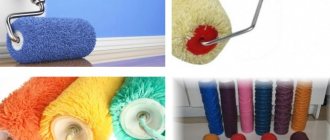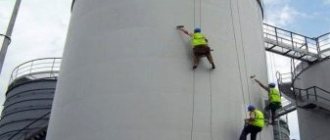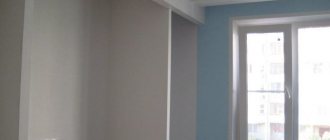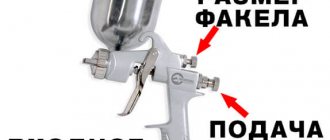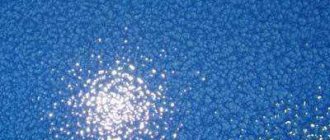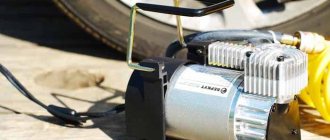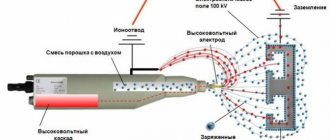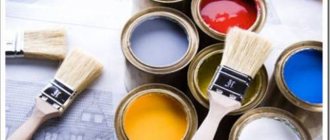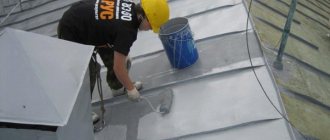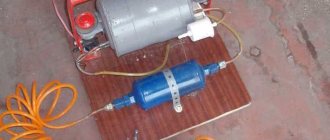We determine the paint consumption for painting a car. Table for calculating the required volume of material.
When you paint a car yourself, you save a lot of money, which is why many people are interested in the question of the technology for carrying out all the work. But one of the main questions that worries novice car painters is: “What is the paint consumption for a car?” Paint is not a cheap material at all, and you don’t really want to buy too much; you’ll end up throwing money away. You will not be able to get an exact answer to this question, since many factors influence the volume of material.
What affects consumption?
At first glance, the main parameters include the surface area that needs to be processed and the number of layers of material that are planned to be applied.
But in fact there are other factors.
In particular, many craftsmen recommend the use of primers, paints and varnishes from the same manufacturer. This way, you can avoid defects and save on car paint consumption for all sorts of alterations.
Which paint should you choose for your car?
In fact, there are several different types of auto enamels that are used to apply to the car body at home.
Car paint consumption rates
On average, to paint, for example, a door or fender, you will need about 150 ml of paint, about 250 - 300 ml of material for a bumper, and about 600 ml for a hood.
On average, the consumption rate is 200-250 ml per 1 sq.m. treated surface. The varnish consumption is approximately the same, this does not take into account the solvent and hardener.
An average sedan, if the technology is followed, requires about 2 - 2.5 liters of acrylic paint, excluding solvent and hardener. If you use alkyd paint, its consumption will be slightly higher than 3 - 3.5 liters. If your task is to paint all surfaces inside the body, then the material consumption will increase by 1.5 - 2 times.
If, when repainting a part, the old paint was, for example, black, and you decided to apply a white layer, then the consumption will increase by 50%. This occurs due to the application of additional overlapping layers.
We will provide a table that will help you roughly navigate the paint consumption for individual parts of the car body.
Here is a useful video on the topic of calculating material consumption when painting a car.
What if you use aerosol cans?
They are mainly used for local repairs, and one can has a volume of 150 grams of paint. The average paint consumption for painting a car using an aerosol can will be from 0.25 sq.m. up to 0.5 sq.m.
For 1 sq.m. For the surface to be treated, we will need about 2 - 4 cans of paint and the same amount of varnish.
Source
How much spray paint will you need?
Paintwork in cans is indispensable for small-scale repair work. Manufacturers declare its consumption:
- 150 ml is enough to paint 0.25-0.5 m² of surface in 1 layer or an area of 0.25-0.38 m² 2 times;
- 400 ml can be painted on an area of 0.65-1 m² in 2 layers.
The consumption of aerosol paint depends on the skill of the master and the same factors as when processing other types of paintwork on the body.
There is a special acrylic paint for wheels that improves the appearance of the entire car. It is applied 2 times. For 4 discs, 2 400 ml cans are enough.
Aerosol auto enamel is the most convenient and affordable coating material. It lays evenly even on shaped structures, is economical, and has high protective properties.
Factors that determine paint consumption per car
Painting at a service will entail considerable expenses; it is cheaper to do it yourself. But when choosing the latter option, you need to have certain skills and calculate the paint consumption for the car. The quantity is influenced by several factors:
Next, we will analyze all these factors in more detail.
Machine size
It is quite difficult to accurately determine how much paint is needed to paint a car. Below is the approximate paint consumption for individual parts.
| Detail | Consumption in ml/l |
| Door | 200 |
| Wing | 150 |
| Trunk | From 300 to 400 |
| Roof | 400 |
| Bumper | 300 |
| Back panel | 250 |
| Radiator grille | 100 |
| Threshold | 150 |
Paint color and original body color
The consumption of paint and varnish material will depend on the original color of the car. If the color is contrasting with the original, more paint will be used than with standard coloring.
You need to know: dark colors do not overlap well with light shades.
It is necessary to apply paintwork in several layers. For example, red or yellow do not cover the substrate well. It may take about 9 or 10 coats of paint to completely cover. Black, green and their shades cover the base well.
Paint viscosity
Of all the parameters when painting a car, the most significant is the viscosity of the paintwork material. It depends on how correctly the coloring composition was diluted. Most cans indicate the proportions that must be followed when mixing the activator and paint. It could be 2:1 (or another value). In this case, dilute 2 parts of the dye and 1 part of the activator.
It is strictly forbidden to add all the ingredients by eye. Such an experiment can lead to the paint being either too thick or thin. In the first case, when painting, an “orange peel” effect occurs, and in the second, drips form.
A viscometer and a graduated container will help you calculate the required number of components. The operating principle of this device is to pour a certain amount of liquid into a special container through a hole of a certain diameter. The device's stopwatch records the time.
If you don’t have a professional measuring tool, you can use a regular ruler. It is placed in a container and a coloring agent is poured. The ruler scale determines the amount of activator that needs to be added.
Important: Viscosity may depend on the room temperature, as well as the surface of the parts. When the temperature in the garage is cold, “tears” form on the painted surface. It is better to perform coloring at a temperature not lower than +23C.
It is worth considering that the thicker the paint, the better its coverage, as a rule. This means that fewer layers will need to be applied than when using a less viscous material.
Type of spray gun, tools
Experience in car painting
Having skills will help reduce the consumption of paints and varnishes. There are a number of rules that should be followed when painting a car, otherwise the enamel layer will lie unevenly and you will have to additionally cover it. This may entail additional material costs. Therefore, if you have no experience in painting, then you should practice on some unnecessary surface.
Paint for your own car – which one to choose?
Based on the chemical components that make up car enamels, there are several common types of paints that can be used in garage conditions:
Nitro enamels have a number of disadvantages: they are flammable, not sufficiently stable (fading quickly), the working layer of the composition is very thin, so multiple painting in several layers is required. They are gradually being replaced by more modern materials.
Glypthal takes a long time to dry, and a high temperature is required for drying; they have a long polymerization period - 2–4 weeks. This is quite inconvenient given the modern rhythm of life.
The most common type used for painting a car in a garage environment is acrylic paint. Acrylic paint consumption for a medium-sized passenger car is 2–3 liters.
Most acrylic enamels are two-component - to activate the composition, it is necessary to add a hardener, and then reduce the viscosity with a solvent. Acrylic varnish is not added to the mixture; the enamel itself gives a good shine. If you want to strengthen it with varnish, this can be done only after the acrylic layer has completely dried, since the evaporation rate of the compositions is different, and when applied wet, specific cracks are formed on the surface - craquelure.
How to calculate the consumption of paint and varnish?
To calculate how much paint or varnish is needed to paint a car or its parts, you can use the average rate. According to approximate calculations per 1 sq.m. body, ¼ liter is spent. material. It follows from this that a vehicle will need 3.5 - 4 liters of paintwork.
As for the varnish, its consumption will be the same as the coloring composition (for a two-layer coating, the amount of substance must be multiplied by two). The amount of varnish also depends on the covering power of their base. Taking this parameter into account, in order to save on consumption, it is better to choose compounds made from synthetic resins. Nitro-combined and acrylic analogues “cover” the paint worse.
Paint consumption in cans
An economical option when painting a car is a can of automotive enamel. In addition, using a can is very convenient when painting individual parts.
In this situation, as in the case of ordinary paint, there are only approximate cost estimates. The table shows approximately how much varnish and spray cans are needed for painting different car parts.
| Detail | Aerosol quantity | varnish |
| Front, rear bumper | 3 pcs. | 350 ml. |
| Front, back door | 3 pcs. | 250 ml. |
| Roof | 4 things. | 400 ml. |
| trunk lid | 3 pcs. | 300 - 400 ml. |
| Hood | 3-4 pcs. | 400 ml. |
| Wing (front, rear) | 2 pcs. | 250 ml. |
| Threshold | 1 PC. | 100 ml. |
| Trunk lid hatchback, jeep | 3 pcs. | 300-400 ml. |
| Side racks | 1 PC. | 100 ml. |
| Side mirror | 1 PC. | 100 ml. |
Taking into account all the above nuances when painting a car, you can reduce the likelihood of overuse of paint and calculate the approximate amount of material required. Of course, the main criterion for paint consumption is the size of the machine and the viscosity of the material itself.
Factors determining paint consumption per car
The quality and quantity of material for body paint repair are directly related: enamels have different covering abilities, but the technology for applying the selected material is taken into account when calculating paint consumption for painting a car. There are nuances to using a brush and a spray gun: by using the right or correctly configured tool, you can reduce the amount of wasted auto enamel to the minimum specified by the manufacturer. Masters claim that this parameter is primarily influenced by experience, but the problem of calculation often faces novice painters, so in the calculations below it is assumed that the painter acts without fanaticism and serious miscalculations.
Determination of flow rate by area
The division into varnishes, enamels and primers is more necessary for manufacturers and sellers to expand the list of products - in fact, the composition of these materials includes the same substances with different ratios. It is generally accepted that no more than a quarter liter of paint is used per 1 m² of car surface. The same figures can be seen in the recommendations for calculating the consumption of varnish, primer, etc. On average, 2.5 - 3.5 liters of finished enamel are spent to completely cover the substrate of the entire car. Approximate calculation for class “D” car parts:
door – 300 ml;
The above data is suitable for calculating complete painting with finished enamel (i.e., adding a hardener and bringing it to the desired viscosity), but several factors can affect the result for the worse or for the better. Local repair of damage involves the use of auto enamel of the same color, so covering power is not of paramount importance here and the amount of wasted material can be minimized. For the worse, the result will differ if the car's substrate does not match the color of the applied material: painting a white substrate with black enamel and vice versa means that the figures given can be increased by 30-50% (at least 1 additional layer will be required). On average, light colors and rich greens have the best hiding power; deep red and blue are in the middle of the calculation scale, but blue depends on the shade; yellow and light shades of red provide the worst color overlap.
And yet, how much is needed?
If we sum up some results, we can operate with the following more or less reasonable figures.
Individual parts
For an average part such as a wing, door, etc., it will take about 0.15 liters, for painting a bumper, taking into account the dimensions, it will take from 0.25 to 0.30 liters, for the hood - 0.4-0.6 liters of paint. For varnish the consumption is exactly the same without taking into account the hardener and thinner and for two-layer application.
The table below summarizes all the figures discussed in this text.
It indicates the volume of undiluted enamel, taking into account the cost of tinting. The colors of paints with low covering ability are also reflected, i.e. the maximum costs.
How much does it cost to paint a car?
The temperature of the room and paint affects the final result. If the temperature in the room where painting is carried out is low, after drying, tears of frozen paint may appear on the body of the machine.
A solution that contains too much coloring enamel will be very thin. The hardener can be used at a temperature of 20 - 23 ° C.
As mentioned earlier, to paint an ordinary passenger car, on average you need to spend 2.5 - 3 liters of paint. The larger the car, the greater the consumption, so an accurate calculation of the amount of product must be made per 1 square meter of vehicle. If you don’t know how much paint is needed to paint a car, you should calculate using the formula N = ¼/1 m2.
Paint consumption when painting a car: car hood - 0.5 l, bumpers - 0.25-0.30 l, roof - 0.4 l, trunk - 0.3-0.4 l, radiator grille - 0.1 l , rear and front fenders - 0.5 l, sills - 0.15 l, car doors - 0.3 l.
Factors affecting paint consumption
In addition to the quality characteristics of the selected material, specific conditions can affect consumption. It is not difficult to guess that thick enamel will require a larger volume, but the working viscosity of the paint may depend not only on the manufacturer’s instructions, but also on the ability of the master to control the process. An attempt to fill the surface with enamel diluted to the limit will lead to the appearance of smudges, but temperatures above normal will require a liquid material. The solvent should completely evaporate from the car enamel during the drying process, but the air temperature and the viscosity of the substance make serious adjustments to the car painting process.
The amount of hardener should not depend on temperature, but the volume of solvent is indicated by the manufacturer for a temperature of 20-23 ˚C. The selection of viscosity should not be done by eye, otherwise it will be difficult to avoid not only increased material consumption, but also obvious defects. The technology for controlling viscosity with a viscometer is to determine the viscosity of a substance by measuring the time of pouring the required volume of liquid through a hole of a certain diameter - you will need the viscometer itself and a stopwatch.
Surface preparation also has its share in quantitative costs. Surface treatment for different types of materials differs, and this difference is most noticeable in the grain size of the abrasives. It is difficult to coat a primer sanded with P400 with acrylic, but preparation for the primer itself involves working with coarse grains. For standard enamels, matting the primer or metal with P800-P1200 abrasives is required: finer-grain sandpaper will lead to worse adhesion, coarse grain will require a larger volume of substance and will cause defects.
Preparing to work with aerosol paints.
1. Aerosol paints can come in different color variations and are produced by different manufacturers. Therefore, find out what exactly is on sale in your region and decide in advance what will best suit your specific requirements. To carry out professional painting, you will need to purchase some additional materials.
- More expensive spray paint is great if you don't have much time, as it requires much fewer applications on the surface to be painted compared to cheaper paints.
- It should be noted that for light colors it is advisable to use a multi-layer application method, so you may have to buy a couple of cans of paint of the same color.
- If possible, it is recommended to use a primer during the painting process, as it allows for much better adhesion of the surface to the paint, resulting in an improved paint color and a smoother finish.
- To protect your work surface from scattered paint, prepare old newspapers and polyethylene.
- Make sure that you always have old rags on hand to wipe the surface from paint drops.
- If desired, you can use carpenter's tape to fence off certain areas of the surface being painted or to achieve smoother edges during the painting process.
- It is advisable to use gloves and a special mask, since aerosol paint is a very toxic substance.
2. Cleaning of painted surfaces . Since spray paint adheres very poorly to dirty and dusty surfaces, it is advisable to clean the surface before painting.
- For these purposes, use either a damp cloth or special cleaning products.
- If there are remnants of stickers, such as store price tags, on the surface, be sure to thoroughly scrape them off before painting.
- For polished surfaces, it is better to use sandpaper, as this will allow the spray paint to adhere better.
3. Preparation of the work area. to work with aerosol paint in well-ventilated areas or outdoors. If working in extreme cold or high humidity, spray paint will not cure properly, so it is recommended to paint when the humidity level is below 65% and in sunny, warm weather.
- Spread newspapers on the ground and press them down with stones so that they do not fly apart when the wind blows.
- Cover with tape the areas that you want to protect from accidental splashes and drops of paint. Make sure the edges of the tape are firmly and firmly attached to the area you do not want to paint.
- To protect your respiratory organs and hands, wear a mask and disposable gloves.
How to dilute varnish for car painting?
There are several types of varnish compositions. Their consumption will depend on the ability to form a glossy surface on the car body and on the type of surface to which they are applied. The varnish must be diluted in strict accordance with the instructions.
headlight varnish treatment
All ingredients must be carefully filtered (you can use a special filter or regular nylon for this). It is better to prepare the mixture in a special container and not dilute a large amount at once. You need to add to the varnish:
Various additives will make the painting process easier, but there is an increased likelihood of side effects. Therefore, it is necessary to strictly follow the dosage indicated in the instructions.
Next article: DIY ventilation in a paint booth. Previous article: Do-it-yourself tinting of headlights (lanterns) with film and varnish, video.
Determine how many liters of paint are needed to paint a car. Tips and approximate figures.
Whatever type of painting work you perform, be it a complete repainting of a car or a local type of repair, in any case you will be faced with the problem of selecting the necessary consumables. One of the most frequently asked questions that interests many is how much paint and varnish does it take to paint a car? After all, the final price of the work depends on the volume of these materials, and paint and varnish for cars are quite expensive, so no one wants to waste extra money. It is worth noting that you will not be able to guess the volume of material 100%, but it is quite possible to reduce the remainder.
Consumption of different types of paints
It's no secret that alkyd enamel costs more than acrylic enamel. The difference between these enamels for cars ranges from 40-60%. Thus, 3 or more liters of alkyd enamel will be used to completely paint the car. The quantitative characteristics of the technology, which includes working with varnish, depend on the covering power of the substance used as a base. Varnishes made from synthetic resins have proven themselves to be the best; the covering power of nitro-combined analogues is noticeably behind.
The most difficult thing is to standardize the painting of metal with a spray can. On average, no more than 4 cans are consumed per 1 m² of a car, however, most manufacturers indicate that consumption per 0.5 m² is equal to 1 can, i.e. you will need half the amount of paint. Using a good spray gun also allows you to save on car enamel, but the adjustment of HLVP systems depends on specific circumstances (in particular, on the pressure in the compressor), and therefore requires test paints or extensive experience working with this particular tool.
Preparing the surface for painting
Does the car body need polishing immediately after painting? Each bath requires a personal approach. Restoration work and preparation for it are no exception.
Preparing an iron bath for painting with enamel
Before painting, the bathtub must be prepared for work. The inner surface of the cast iron bathtub must be completely cleaned of residual grease and traces of limescale. To combat them, the most common alkaline agent is suitable. For example, the traditional Pemolux. On the contrary, it is recommended to refrain from using substances containing chlorine.
Product with a little added water:
Next, the master will have to begin cleaning the bathtub from rust, traces of old paint and dirt. For this you will need:
In this case, the power tool is unlikely to reach the inner corners of the bathroom and the drainage area. This is where sandpaper comes into play.
The result of manipulations with an electric drill or grinder should be a matte and rough surface to the touch. There is not much left to do before painting begins:
Preparing a bathtub for acrylic painting
Acrylic painting also requires special preparation. Otherwise, within a few days after the work, an emergency may occur - the paint will begin to peel off. To prevent this from happening, you must:
Getting moisture under the paint can ruin the whole job. Even a minimal amount of water will be destructive and lead to irreversible processes.
Drying the bath during the preparation stage should be given the closest attention.
It is also important to ensure that after applying acrylic nothing falls into the freshly painted bathtub
It is also recommended to secure the washing machine - wrap it in plastic and secure it with tape.
How long does a can of car paint last?
428000, Cheboksary , F. Engels St., 31
424000, Yoshkar-Ola , Solovyova st., 26
Aerosol paint in cans is a small-volume metal container with a spray valve, into which a paint mixture of a certain consistency and gas are pumped under pressure under factory conditions.
When pressing on the spray gun, the gas begins to expand and pushes the liquid paint out through the tube through the spray valve.
The can also contains a metal ball for stirring the paint. Before use, the can of paint must be shaken for a certain time, while the ball inside stirs the paint until smooth.
Enamel, sold in aerosol cans, is a quick-drying paint that usually has a high degree of adhesion to any enamel coating. It is widely used for restoration work and coating of bathtubs, refrigerators, sinks, boilers, speakers and many other household items that have an enamel coating. Thanks to the presence of an aerosol, it is easy to apply to a scratched surface; you just need to shake the can well before applying. It provides a durable coating layer that is sufficiently resistant to temperatures up to 100 degrees.
When using any aerosol paints, in this case enamel from a can is no exception, it is important to adhere to the following safety rules:
Types of aerosol paints Enamel
Consist of acrylic polymer and pigments in a mixture of organic solvents. Mainly used for painting decorative parts of household appliances (refrigerators, washing machines, microwave ovens), furniture, and used in decorative and applied works. They are used for both internal and external work. They dry quickly, are durable, weather-resistant, and have excellent adhesion to various types of materials. This type of paint is applied at ambient temperatures from +10 to +30 degrees Celsius. Be careful with the can as the enamel vapors are explosive.
Varnishes Suitable for decorative works, hobbies and art. The special formula used in these varnishes protects the surface from cracks, gives a glossy shine and provides protection from environmental influences. This varnish is suitable for any surface.

